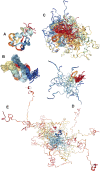Intrinsic Disorder and Posttranslational Modifications: The Darker Side of the Biological Dark Matter
- PMID: 29780404
- PMCID: PMC5945825
- DOI: 10.3389/fgene.2018.00158
Intrinsic Disorder and Posttranslational Modifications: The Darker Side of the Biological Dark Matter
Abstract
Intrinsically disordered proteins (IDPs) and intrinsically disordered protein regions (IDPRs) are functional proteins and domains that devoid stable secondary and/or tertiary structure. IDPs/IDPRs are abundantly present in various proteomes, where they are involved in regulation, signaling, and control, thereby serving as crucial regulators of various cellular processes. Various mechanisms are utilized to tightly regulate and modulate biological functions, structural properties, cellular levels, and localization of these important controllers. Among these regulatory mechanisms are precisely controlled degradation and different posttranslational modifications (PTMs). Many normal cellular processes are associated with the presence of the right amounts of precisely activated IDPs at right places and in right time. However, wrecked regulation of IDPs/IDPRs might be associated with various human maladies, ranging from cancer and neurodegeneration to cardiovascular disease and diabetes. Pathogenic transformations of IDPs/IDPRs are often triggered by altered PTMs. This review considers some of the aspects of IDPs/IDPRs and their normal and aberrant regulation by PTMs.
Keywords: intrinsically disordered protein regions; intrinsically disordered proteins; multifunctional proteins; posstranslational modifications; protein–protein interaction (PPI).
Figures




References
Publication types
Grants and funding
LinkOut - more resources
Full Text Sources
Other Literature Sources
Miscellaneous

